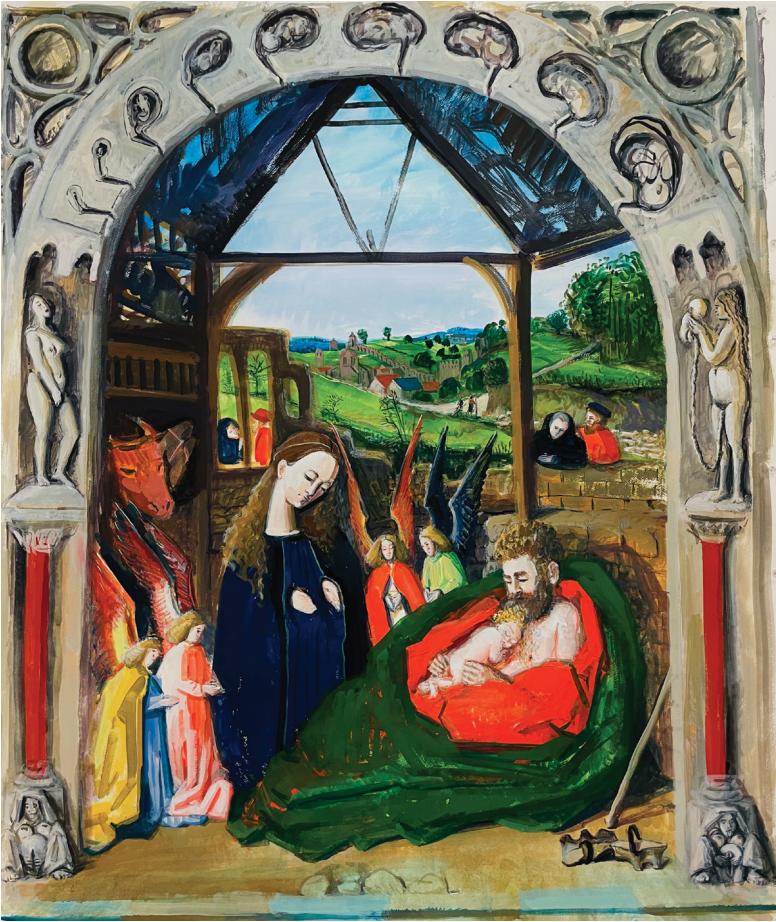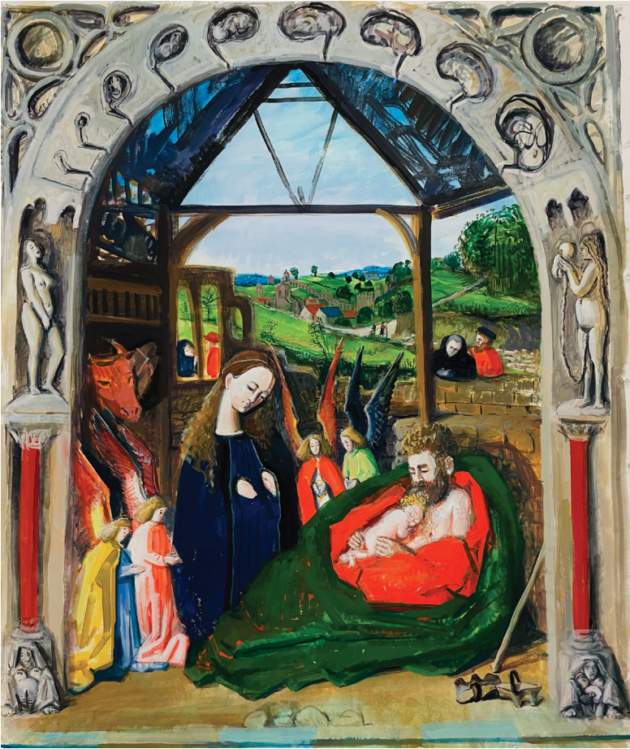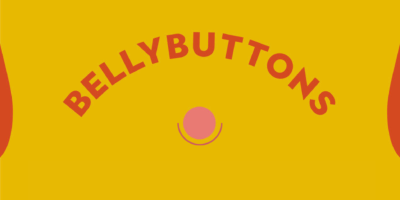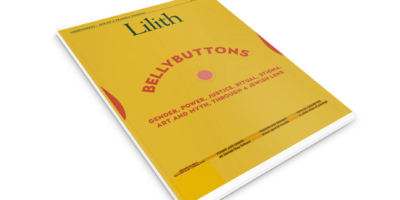
How the Navel Was Erased in the Service of the Penis
For my 70th birthday, my daughter Anna offered to throw me a Zoom party. I invited my dearest friends; all women, except for Paul, who agreed to be a “girlfriend” for the purposes of the evening.
I told Anna that I wanted the theme to be bellybuttons—though, to be honest, I hadn’t done a stick of research on the matter. But I’d always known that something was misogynist about the navel’s trivialization. After all, the navel, our primal scar—at the very bullseye of our bodies—manifests the most numinous experience that all of life has to offer: that we were once inside someone else; that we, in fact, were someone else; and, for those of us with uteruses who have birthed children, that someone used to be on the inside of us, too.
Ex Utero, we eat and drink with our mouths, but in utero we “ate and drank” with our umbilical cords, to which our navels, gnarly little artifacts, offer testament. A tattoo on our navels should proclaim, like a dreidel, “Nais Gadol Hayah Po!”—“A Great Miracle Happened Here!” Not only because one became two in a journey limning attachment and separation, but because this miracle happens eternally, in perpetuum: attachment, separation, loss, attachment, separation, loss, attachment…. Instead of being hallowed as placental mammals’ most sacred site, however, our navels have been thoroughly “disappeared.”

Tirtzah Bassel, The Nativity (after Petrus Christus), 36″x42″, gouache on paper, 2021.
It does not take a genius, then, to recognize that “womb envy” includes “navel envy.” And it goes without saying that “penis envy” is a sad little flaccid defense against what many women’s bodies can do: not only create human beings—like, uhh, God—but manufacture those little humans’ compleat victuals as well. For those without uteruses, sanctifying the bellybutton (and now we’ve got breasts in the mix, too) would require dealing more explicitly with feelings of inferiority. (I fully acknowledge that gender is a spectrum, and that the binaries in this piece necessarily eschew some complexity; in any case, what gets coded as “female” becomes culturally denigrated.)
The attachment-theorist D. W. Winnicott goes further. Besides the dilemma of biological males having all started their lives inside a woman, he says, the larger sticking point is that males are dependent on a woman (generally a mother) for way too long after that. Male dependency needs are considered a sign of weakness in most societies, so if we were to advertise “attached here,” say, on the most prime real estate of our torsos, it would probably awaken feelings of masculine shame.
The navel also gestures towards our mortality: that we commenced our lives in some numinous, beyond-reach “cave,” and that we will terminate our lives in a similar place of “unknowing.” As T. S. Eliot wishfully put it: “… the end of all our exploring/ will be to arrive where we started/ And know the place for the first time.”
Freud described the navel, like women, as “unplumbable, a point of contact with the unknown,” an intimation of the hard fact that our lives begin and end without our actual “presence.” And Winnicott often said that his deepest wish was to “be alive when I die”—to consummate the human adventure, as it were, by the experience, not only post-death, but also pre-birth, of “no boundaries.” But no human gets to do that, and bellybuttons—rough-cut holes to nowhere, after all (eroticized by the sirenic tease of being able to feel a navel with our finger or tongue, but not actually see or spelunk in there)—refuse that.
The food writer, M. F. K. Fisher, famously said, “One of the most private things in the world is an egg before it is broken.” The navel suggests a private offstage sanctum, too, but, alas, post-breakage. Mothers, in our visible world, can never live up to the sublime little planets they provided for us rent-free in utero; as feti, we wished only to “go on being,” as Winnicott put it. Feti have no frigging clue that there will be this immense frustration, in the outside world-to-come, called “a need unmet.” On some level, we hold this, too, like many ungenerous grievances, against mothers.
Bellybuttons, therefore, also signify a kind of banishment from Eden, and, beyond that, a complex semiotics: attachment and severance, comfort and vulnerability, the ability to hold dialectical irresolutions and paradox, the signaling of mortality, and, if you’re biologically a guy, a recognition that your navel is a dead end, a wooden nutmeg that publicizes your inability, unlike biological women, to make a navel.
Meanwhile, back in our very attached female world, we women crank out bellybuttons generation after generation, all the way back, in our maternal haplogroup, to Mitochondrial Eve. Our omphali are different from men’s, warming us up to the idea that an “organism” might be bigger than just one human individual: an organism might be this holy infinity chain of women … of which each of us is just a fragment.
HANG IN HERE with me as we trace some historical navels and the matricide that befell them. I started my research by looking up “navels of the world,” and, indeed, there are dozens of these places that once claimed they were ground zero of Creation: in Serbia, in Egypt, in the Incan capital city of Cusco, on Easter Island, at various Greek sites, and—shock of shocks!—even under the alleged “Foundation Stone” in the Holy of Holies in the Jewish Temple of Jerusalem—yes, in accord with our patriarchal origin stories, the self-same place where the world was created, where Adam was “born,” where Abraham bound Isaac on the altar, where Muhammad launched his journey to heaven … underneath all of this was an originary Earth Mother worshipped in a watery subterranean cave!; our patriarchs engineered that matricide.
In ancient times, “navels of the world” were generally in watery caves or on mountains, or in caves on mountains, and each site was understood identically: as an axis mundi, the center of Creation, the place where the terrestrial realm connected not only to the subterranean one below, but also to the celestial one above. And the whole cosmos, it was understood, revolved around this axis mundi: It was THE place where all the world’s realms were connected.
The axis mundi was not always a navel; sometimes a vertical object supplemented or replaced it, representing, again, the safely battened cosmos: the object might be an umbilical cord, or a pillar (like the “asherah” in Hebrew Scriptures), or a tree (like Deborah the prophet’s palm), or a menorah, or a ladder (like the one Jacob’s angels zipped up and down on), or a cross (as in Jesus), or a column of fire or smoke (as in Exodus 13), or a steeple.
Sacred omphali, though, dedicated to an Earth Goddess, seem to have been the earliest axes mundi. (Scholars point out that later designations of a “world navel” were probably manufacturing claims to political centrality.) Pre-Mayan sculptors in Central America made the navels of their massive statues out of magnetized stone, underscoring that bellybuttons were the origin of the human life-force. And androcentric medical theories held, for a shockingly long time, that human embryos begin their formation at the mother’s navel.
Many old churches in Europe have crypts underneath that were once worship sites to an earlier chthonic Goddess, and many sites dedicated to a male God like, say, Apollo or Yahweh (a man-God, in case you haven’t been paying attention, whose name is the self-same one as the lightning-wielding Gods Jupiter and Jove) mansplained away earlier “pagan” (generally, female-centered) cultic sites over the course of centuries until those cults were prodigiously contorted or entirely expunged. I was shocked to discover how common it still is for contemporary male scholars to continue this matricide; the scholar-rabbi Daniel Sperber, for example, inexplicably calls the famous Omphalos of Delphi a “phallus.” (I cannot imagine what his daughter—the Bat Kol founder, Avigail Sperber—makes of this.)
The Omphalos of Delphi in Greece, the most heavily trafficked pilgrimage site in antiquity, located on a steep lower slope of Mt. Parnassus, was originally dedicated to Gaia (the parthenogenic Mother-of-All-Life), but then, over time, was “rescripted” by patriarchal mythologies to become known, even today, as the ahistorical Temple of Apollo.
Many myths attest to the “marital decoupling” of Earth Goddesses and Sky Gods, but the Delphic myth (of which there are varying versions) is one of the most renowned. Cronos (Saturn) swallows each of his children so that they don’t overtake him, but his wife Rhea swaps out their last child, Zeus (a.k.a. Jupiter), by hiding him in a cave sacred to Zeus’s grandmother, Gaia (she leaves his umbilical cord there, occasioning pilgrims to the cultic site to deposit their children’s cords there as well), and instead gives Cronos a stone wrapped in swaddling clothes which he swallows. Zeus then kills his mother, thus severing the mythopoetic umbilical cord, and the worship site becomes dedicated to him, though even today you can visit the Omphalos Stone, the navel of Delphi, on which is carved a pattern that represents the netted swaddling and has the telltale word “Ga” on it, attesting to Gaia.
Interestingly, omphalos stones were also called “baetyls,” and there is a case to be made that this word becomes “Beth El”—the “pillow” under Jacob’s head (Genesis 28:18-19) which he sets up, anoints with oil, and divests from its female reproductive associations.
For centuries, however, even though Gaia’s Delphic site became Apollo’s Temple, a Pythia—an authoritative female oracle (first a young virgin, much later, because of rapes, a crone dressed as a young virgin)—would sit inside the cave (the portal to the Underworld where the Omphalos stone was) and relay, in a state of divine possession, prophesies from the originary Earth Mother below. It is now understood that many of these “earth navels” were cave systems that were oxygen-depleted, thereby promoting dopamine-heightened hallucinations. (“Intoxicating fumes,” one writer of antiquity explained, “loosened the lips of the Pythia.”) Below the Delphic temple, two faults actually intersect and produce gases—ethylene, ethane and methane—which induce out-of-body experiences and altered states of consciousness.
The Talmud describes how, when the Temple was built, there was a pit under the altar into which the blood of sacrifices drained. Pits were dug down to “tehom,” the rabbis explained; that is, to the “world’s navel.” In Genesis 1:2, tehom is generally translated as “the Deep,” but in origin this word was the name for the Goddess Tiamat, an oceanic Mother deity.
We read, “… and Darkness was upon the Face of the Deep, and the spirit of God hovered over it,” as a simple Creation story, but it was, at one point, a heterosexual fornication scene wherein the dark-passaged Earth Goddess from below and the “hovering” or “lusting” phallic Lightning God up above have intercourse and create the world. (Pandora’s “box”, as we call her female nether parts,is the same externalization of the gynophobia that we see in this idea of tehom: a monstrous, male-projected, female embodiment of primordial chaos.) The Talmudic rabbis, reeking of misogyny, invented the idea of a Foundation Stone (“even ha’shetiyah”) in the Holy of Holies whose purpose it was to seal off the “female waters of the Abyss” which threatened to overwhelm the world, a fear of women that’s just as threatening to men of the 21st century.
“Omphalos grottoes”—cave entrances to the Underworld—were labyrinthine, not unlike, it was believed, navels or labia. “Labyrinth” comes from the word “labrys”—an asymmetrical double-headed axe which always accompanied Goddesses, never male Gods. In Crete, it was one of the holiest symbols, representing the Earth Goddess’s authority. It, too, though, was somehow tarmacked over to become a symbol of Apollo and/or Zeus, the Lightning God.
We also see, centuries later, gynophobic churches constructing “labyrinths” on their floors, but these are no longer mazelike underground “navels” suggesting women’s mysterious generative parts; they are, instead, frigging structured paths, male and martial, violent appropriations by weird celibate men of that which was once female and sacred.
So now we get to this thing in the innermost chamber of the Jerusalem Temple called, in the Bible, the “d’vir”—which is often not translated, but rather glossed as “the Sanctuary,” “Holy of Holies,” “Middle of the Earth” (or, as in the Septuagint, retained untranslated as d’vir). Though this etymology is contested by scholars, it does synch with the modern Hebrew word for bellybutton (“taboor”), as “t” and “d” are trilateral-root variants, and so are “v” and “b.” Under the Holiest of Holies, that is, there was a sacred omphalos site!
In Crete, the famous underground labyrinth appears as the Mycenaean Greek word “du-bu-re” or “da-pur-ri-to”—that same trilateral-root bellybutton word, and the word “labyrinth” itself becomes “dabyrinth” (in ancient Greek, “d” and “l” sounds are interchangeable), and then we see that “dabyrinth,” too, is related to “d’vir,” and, not only that, but—here’s the one I didn’t understand for a long time—related to Mount Tabor; that is Mount Bellybutton.
But why would a mountain be a famous omphalic site? This made no sense to me, though Mount Tabor is an ancient sacred site (where Jesus was, significantly, transfigured; where there remain today churches and monasteries). It was probably once matriarchal and later became patriarchal. Though male scholars point out that t-v-r (or t-b-r) might also mean “high point,” a different explanation—not only in relation to Mount Tabor, but also in relation to “outie” omphali misunderstood as phallic—seems patently more historically empathic to me.
Mount Tabor, the Omphalos of Delphi, and other “outie” navel sites are ex-negativo: that is, if everything that lives on Earth comes out of the body of the chthonic Goddess—soil and trees, oceans and people, animals and flora, everything we eat—then we are inside of Her still, and from the inside, an “innie” becomes an “outie,” like a mountain. It’s also the case that pregnant women all become outies in their latter weeks, and the Earth-Goddess-Lady-Shekhina is, of course, eternally pregnant with us. I find this understanding plausible and exciting.
Finally, let’s look at the female-positive book of Judges, arguably the most confounding book in Hebrew Scriptures, which scholars admit they have not yet entirely cracked. In Judges, who should come down from Mount Tabor, but Deborah (d-b-r)—the bellybutton Earth Goddess! She’s with her “consort,” as deities often were, the Lightning God Barak (“barak” means “lightning,” as in the Lightning God Apollo and/or Zeus)! Get out!!!!
Though I am alone in positing this, it certainly reads like a mythopoetic text maintained but stripped of its power (as we often see in Hebrew Scriptures), Deborah and Barak becoming humans instead of Gods, but, oddly, military allies—a textual re-write intended to pull in clans with different dedicated theologies in order to serve a biblical political goal.
All of this to say that patriarchies have disfigured and ransacked so much that was female-positive, including women’s and Gaia’s native understanding that everything on Earth is connected. Our bellybuttons are manifestations of women’s spectacular power derived from relatedness. Is there anything in our ecologically catastrophic times that could be a more crucial Gaia-recursive message about female embodiment, female connection, and our deep female discernment of Earth’s essential and indivisible sanctity?
It’s time to bring back the chochma [wisdom] of the navel.
So let’s imagine, in a contemplative moment, paying homage to our bellyroots:
• There they are: doughy little pulkes, not unlike another “set aside” sacred troche: the little piece of
dough (the size of an olive, or navel) that Jews are commanded to separate from the larger challah they’re kneading in order to ceremonially burn it in the oven. This mitzvah is called “taking challah,” and it’s done in memory of the tithing loaves that those baking bread in biblical times were commanded to bring to the Temple. These stale little holy ends of our umbilical cords, our
navels, remind us of this.
• The umbilical cord is said to be stunningly beautiful in utero, its colors otherworldly—fluorescent cobalt and amaranthine. And its blood is rich in stem cells that can be stored in a family cord-bank. Our navels remind us of this.
• Our umbilici are “dos pinteleh yid”—our little precipitate, the distilled essence of us-ness. Like a finger print, each is an n of 1. Our elegant cords have been dispensed of in the hospital, but this unspackled bit remains ours, reminding us not only that we came from Her—but, like a golden ratio, that we stretch all the way back to Time’s beginning, womb to womb. Our navels remind us of this.
• And our navels are “relics,” precisely so, as “relic” means “remainder” or “left over.” Pilgrims journey for miles to kiss sacred relics (Muhammad’s beard in Istanbul, the Buddha’s tooth in Sri Lanka), believing that these relics will endorse their prayers. A relic is defined as “an object of reverence that was once part of a holy person’s body,” or “an object surviving from an earlier time” or an “objet de vertu.” A bellybutton, then, is the relic of the person who birthed us. Our navels remind us of this.
• Our bellyroots are little altars of tribute to our mothers’ (and our Mother’s) labors, souvenirs from the hours of our birth. They remind us of when we holidayed in our mothers’ substantiated temples, while also acknowledging that maternal connections are necessarily complex. Our navels remind us of this.
• Our bellybuttons, in kabbalistic terms, are alchemal sites of “ein sof”: that neoplatonic, ungraspable thing-without-ending that lies beyond human control and brings us to the threshold of life’s largest, ancient, silent, dissolving dominion. Our navels remind us of this.
• Our navels are concrete reminders that unresolved complexity can be rich and true. Simone de Beauvoir said of women that “we are both separate and connected to each other, a unique subject and an object for others, consciousness and body, free and unfree.” Our navels remind us of this.
I have much more to say about bellybuttons, especially in relation to feminist scholars in numerous fields, but what I really hope for in these articles is that you readers adopt these “prayers of connectedness” in our shared effort to re-sacralize the female body, including the body of Mother Earth, to re-attach the cord that’s been broken.
“To be rooted is perhaps the most important and least recognized need of the human soul,” said Simone Weil. Our bellyroot—newly named—sings Amen.
Susan Schnur, serially a rabbi, writer, and clinical psychologist, lives in Brookline, MA. For many years she was an editor at Lilith, where she authored, among other work, the landmark “Womantasch” articles.
Art: Tirtzah Bassel, The Nativity (after Petrus Christus), 36″x42″, gouache on paper, 2021



